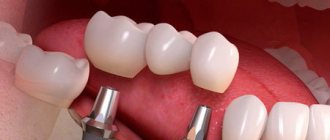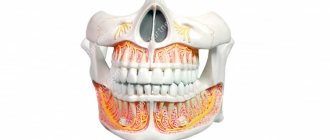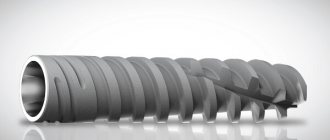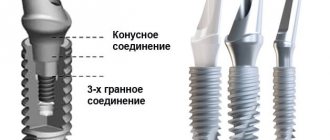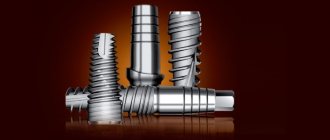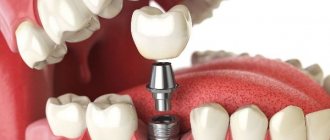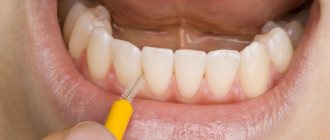The nuances of restoring the lower dentition
Implantation of the lower jaw has its own characteristics. If we compare them with the nuances of restoring the upper dentition, they become absolute advantages.
Firstly, due to denser bone tissue, the process of osseointegration of dental root analogues proceeds much faster than in the case of the upper jaw. Secondly, bone atrophy develops more slowly, again due to denser bone. Thirdly, the likelihood of inflammation of the soft tissue around the implant is minimized, since the density of the bone tissue allows the artificial roots to be securely fixed. Fourthly, the risk of injury to the maxillary sinuses and maxillary nerve is eliminated.
What are the nuances of dental implantation in the lower jaw?
When the question arises of filling “gaps” in the lower dentition, the requirements for the aesthetics of the result fade into the background. However, increased expectations are placed on functionality - implants and prostheses must be guaranteed to be resistant to constant chewing loads.
Alternative techniques
Removable and fixed dentures, unlike dental implants, are not able to stop the atrophy of the mandibular bone in the area of lost teeth. The chewing load falls only on the supporting teeth or gums, so the bone tissue begins to quickly decrease and sag.
Clasp prosthesis
Indicated for included and terminal defects of the dentition. It is a metal arch with artificial gum and crowns, which is fixed to the supporting teeth with hooks (clasps) or attachments (clasps).
More about the method
Bridge prosthetics
Shown when there are no 1-2 neighboring units nearby. The prosthesis is fixed to the supporting teeth with dental cement.
More about the method
Complete removable denture
With completely edentulous jaw. It is held in the mouth by suction to the gum.
More about the method
All specialists Our specialists
Shirokov Yuri Yurievich
orthopedic dentist, candidate of medical sciences
0:45
Stotik Vitaly Vladimirovich
dentist-therapist
When implantation of lower teeth is not possible
An indication for installing an implant is the absence of even one tooth, not to mention complete edentia, when a person is left completely without teeth. Unfortunately, treatment that involves replacing tooth roots with their titanium counterparts is not always possible. There is a fairly impressive list of contraindications for this type of operation. All of them can be divided into absolute and relative.
The first absolute category includes the following states:
- serious problems in the functioning of the nervous and cardiovascular systems,
- labile (unstable) diabetes mellitus,
- tuberculosis,
- chewing muscle tone,
- poor blood clotting,
- oncological diseases,
- impossibility of using local anesthesia and general anesthesia,
- relapses of stomatitis.
Among the relative prohibitions on the procedure are stabilized diabetes mellitus, in which treatment is allowed with the participation of an endocrinologist, as well as a low immune status, HIV infection, AIDS, inflammatory processes in the soft and hard tissues of the oral cavity, and abundant accumulation of dental plaque. In the latter case, professional cleaning at the dentist's office will come to the rescue. It can also be quite difficult to firmly fix dental root replacements if bone atrophy has reached a critical level. This may require a procedure for increasing lost volumes. On the lower jaw, this is the implantation of bone blocks or synthetic material; on the upper jaw, a sinus lift can also be additionally used - since it involves displacement of the nasal sinus, therefore, it cannot be carried out below. Another, alternative option is to install special elongated models into the deeper layers of the jawbone.
But let's take a closer look at what implantation techniques are possible to restore teeth from below.
Classic – dental implantation in 2 stages
The classic method has long been time-tested, but it has its own nuances - both pros and cons. In this case, the entire treatment process can be divided into two stages: first, implants are implanted, and only after 2-6 months can the doctor fix the prosthetic device - this is the time required until the root replacements are completely implanted. The key advantages of this method include the ability to form a beautiful and smooth gingival margin, as in the photo below. This is a very important condition for teeth falling into the smile zone. Most often, this concept is used to fill scattered “voids” in the dentition. If there is a need to restore from 1 to 4 lower front teeth, then this is the best option.
Classic two-stage dental implantation method
As for the disadvantages, the main disadvantage of this method of treatment is its duration. In addition to the fact that the patient will have to wait for complete osseointegration of the implants, it is likely that several months will be required for the restoration of bone tissue volumes. The thing is that this protocol is extremely demanding on the condition of the bone. Since atrophy develops very quickly in the absence of teeth, at the time of contacting a specialist, with a 99% probability the patient has a clear lack of bone tissue for reliable attachment of titanium rods. Additionally, it is necessary to carry out the procedure of its extension, which is very expensive both in time and money.
Features of lower jaw prosthetics
Unlike the upper row of teeth, the restoration of the lower one is somewhat different and has its own characteristics:
- Affordable price. The jaws are designed in such a way that the bone tissue below has greater density than the above. The volume of tissue decreases slowly, so implants can be installed in cases of long-term absence of teeth, without resorting to bone grafting. This allows you to reduce the cost of the procedure by 2-3 times.
- Favorable prognosis. Due to the structure of the bone tissue, the rods take root quickly. In most cases, the recovery process goes well, without complications (unlike implantation in the upper jaw, when the maxillary cavity or infraorbital foramen can be damaged).
The appearance of the lower teeth is not as important as the upper ones. But high demands are placed on structures in terms of functionality: they must be stable and withstand constant mechanical loads.
Rapid recovery with one-step techniques
Today, one-stage protocols have become an excellent alternative to the classical method, allowing for complete dental implantation in just a couple of days. There are two main advantages here - almost instant fixation of the prosthetic device (usually on the same day), as well as the possibility of avoiding bone augmentation by installing implants in the area of the chewing teeth at an angle and using deeper and denser areas of the bone.
Below are the most popular treatment protocols today with the ability to instantly restore your smile:
- Trefoil (All-on-3): the offer from Nobel Biocare is designed specifically for the lower jaw. Three root substitutes are inserted in a straight position into the front part of the jaw, then an orthopedic device with up to 12 artificial teeth is placed on them. This prosthesis is equipped with a durable template beam, which serves as a kind of stabilizer for the implants and prevents them from moving under the chewing load. It is important here that the bone tissue is in normal condition in the front part. The advantage is that it is in this area that it is least susceptible to atrophy,
- prosthesis on 4 implants: Nobel was the first to develop the concept, introducing the All-on-4 protocol to the world. The bottom line is that only four titanium rods are enough for the prosthesis - 2 are placed exactly in the anterior section and one more on the sides and at an angle. The area of contact with bone tissue increases, which allows you to reliably fix artificial roots without the need for bone grafting. Later, a similar concept was proposed by the Straumann company, giving its version the name Pro Arch - everything is the same here, only using the products of the development company,
- prosthesis on 6 implants: this option is for cases of more pronounced atrophy - All-on-6. 2 implants are fixed obliquely on each side for even stronger attachment. Straumann, by the way, has a similar concept called Pro Arch TL, only here all 6 implants of the developer are fixed directly, and special shortened models are implanted into the lateral sections1,
“I am immensely grateful for the unique opportunity to once again become the owner of a luxurious smile, like in my youth. I couldn’t even imagine that I would ever be able to afford implantation, and so quickly! My lower jaw was completely restored, and it only took a week! Only 6 implants were implanted, quickly and completely without pain. Rehabilitation was also surprisingly easy. I'm absolutely delighted! How great it is that medicine is developing so quickly, and there are such wonderful doctors! Thank you again!”
Evgenia Mikhailovna R., 58 years old, review on the website of one of the capital’s clinics
- basal method: in case of acute atrophy and even inflammatory processes, when there are no teeth left on the lower jaw or there are still a small number of them, but they must be immediately removed, the best option would be Basal Complex. This concept, like all of the above, also provides for immediate loading of the prosthetic structure and does not require bone augmentation. Special models of implants that use dense and sterile areas of bone tissue help solve the problem. In addition, their smooth antibacterial coating effectively prevents the development of peri-implantitis.
Read about possible implantation options for periodontitis and periodontal disease in our special article>>>
Today, experts highlight the basal complex as one of the most promising, and here is what Russian experts think about this in the person of Roman Dmitrovich Bespalov, an oral surgeon and implantologist at the Smile-at-Once clinic, where they began introducing instant loading protocols into practice earlier than others:
“This method is a real salvation in cases where it would seem almost impossible to carry out full treatment. We are talking about installing a large number of implants at once, up to 12 pieces in deeper layers. This feature allows you to avoid complex and rather painful bone augmentation, and also achieve excellent stability of the prosthesis. Literally a couple of days after the operation, it is already possible to install a lightweight orthopedic device, which, on the one hand, will stabilize the implants and stimulate the process of their osseointegration, and on the other, will return the patient’s beautiful smile and self-confidence.”
How to understand that the design has not taken root?
There are a number of symptoms based on which you can understand that the dental implant has not taken root or complications have arisen:
- loosening of the structure;
- bleeding;
- pain and swelling;
- purulent discharge from under the product;
- increase in body temperature.
When the first signs of deterioration of the condition or the formation of discharge from soft tissues appear, you should immediately consult a doctor, because this is the beginning of the development of inflammation, which can lead to the inevitable removal of the entire structure and a long recovery.
Possible complications
Like any operation, implantation can lead to some complications, which in the vast majority of cases are the result of poor quality of treatment, as well as errors by specialists, including at the stage of preparation for the procedure. All of them can be divided into early and late, that is, those that can develop some time after the operation.
Problems that may arise in the early stages
Immediately after the implantation of artificial roots, moderate swelling develops, some pain, slight numbness, redness of the mucous membrane, and sometimes an increase in temperature are noted - all this is the body’s normal “response” to injury to the tissues of the oral cavity. Such consequences of surgical intervention go away on their own. However, in rare cases, truly serious complications arise that require immediate help:
- sutures come apart - in this case they will need to be re-applied,
- implant loss - occurs in situations where the parameters of the socket do not correspond to the dimensions of the titanium rod or the condition of the bone tissue and its capabilities was incorrectly assessed at the preparation stage.
Manifestations such as intense bleeding, acute pain, chills, high fever, runny nose and facial swelling should alert the patient. If such symptoms appear, you should immediately see a doctor.
Complications that develop after some time
The development of late complications is usually associated with injuries, acquired diseases and poor quality of oral hygiene. These include:
- peri-implantitis – inflammatory processes in the tissues surrounding the artificial root,
- rejection – may be associated with poor fixation of the product, poor condition of bone tissue or individual characteristics of the body,
- impossibility of fixing the prosthetic structure - the reason for this is errors made when choosing a place for the implant and during its installation.
The photo shows peri-implantitis on the lower jaw
“Today, the likelihood of developing complications after implantation is at a very low level. For example, one-stage techniques involve careful planning of the entire treatment process using advanced 3D computer technologies, which virtually eliminates the human factor at the preparation stage. To carry out such operations, a specialist needs to undergo additional training, have a good understanding of the anatomy of the jaw apparatus, maxillofacial surgery and orthopedics, and modern and rather complex software. In short, very high demands are placed on the professionalism of such a doctor, which is also reflected in the level of quality of treatment. The patient’s task is to take the choice of a clinic and an implantologist seriously,” explains Bulat Vyacheslavovich.
According to expert reviews, such problems can arise both when using the classical method and in the case of tooth restoration using one-stage methods. However, when using systems for immediate loading, the risks are reduced to a very minimum, as there is a less traumatic installation and there is no need for additional procedures, such as bone tissue augmentation.
Types of implantation
Today, there are two types of procedures for implanting an artificial titanium root. The one-stage technique is suitable for those who strive to acquire new, full-fledged teeth as quickly as possible. The procedure is as follows:
- initial examination and medical history;
- selection of materials and types of structures;
- preparing the hole and implanting the product into it;
- abutment fastening;
- fixation of a temporary prosthesis, which is necessary for the period of engraftment;
- replacing a temporary product with a permanent one.
The healing time for the entire structure is two or three months. At this time, you must strictly follow all the doctor’s recommendations regarding taking medications and hygiene procedures.
Two-stage implantation requires a lot of time, since its name speaks for itself, i.e. the entire structure is installed in two visits to the doctor. First, preparations are made for the operation and implantation of the product, and then after rehabilitation, it is checked whether the implant has taken root or not, through examination and x-rays. Ultimately, if everything is well fixed, a crown in the shape of a tooth.
Approximate cost of treatment
As for the prices for treatment using dental implants, everything will depend on a lot of different factors: the number of “gaps” in the dentition, the degree of bone resorption, the choice of a specific technique and brand of implant system, the level of prestige of the dental center and much more. In the table you can find approximate prices for dental implantation, including the cost of the implants themselves, the doctor’s work and the fixation of a permanent orthopedic structure.
| Protocol name | Approximate cost of turnkey treatment, rub. |
| All-on-3 (Nobel Biocare) | from 280,000 |
| All-on-4 (Nobel Biocare) | from 420,000 |
| All-on-6 (Nobel Biocare) | from 500,000 |
| Pro Arch (Straumann) at 4 | from 500,000 |
| Pro Arch (Straumann) at 6 | from 550,000 |
| Basal technique (Biomed) | from 250,000 |
| Recovery in 2 stages (Nobel Biocare) | from 75,000 for 1 tooth |
It is necessary to understand that implants are the only guarantee today to stop atrophy, which is rapidly reducing the volume of bone tissue. Not a single removable or fixed prosthesis can protect against an almost lightning-fast loss of bone volume. Modern methods have taken implantation to a new level and made it more accessible, which has provided excellent opportunities for patients missing several or all teeth at once.
Video review of basal implantation of lower teeth against the background of acute atrophy
- According to information posted on the official portal of the Straumann company: www.straumann.ru.


